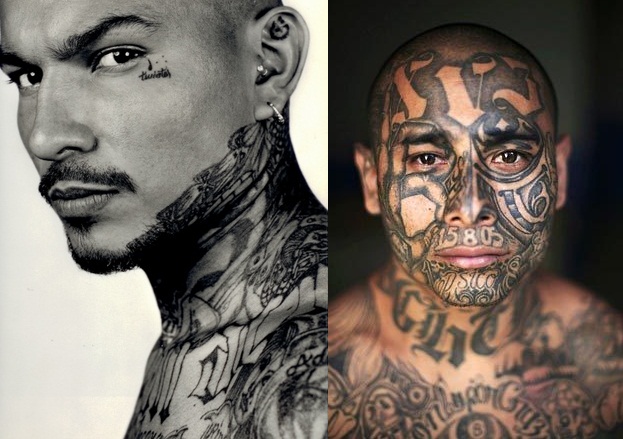
The art of tattooing has become mainstream in today’s society. As tattoos are slowly starting to possess a primarily aesthetic purpose, it is easy to lose sight of the representative value tattoos have had in the past. For incarcerated criminals, the purpose of tattoos is merely in their function; they are a vital form of communication in a world that restricts most other means of self-expression. Both the process and the tattoos themselves allow portrayal of identity, affiliation, and also criminal hardness. The tattooing that goes on in prison is not at all comparable to the tattooing that takes place in the average shop downtown. The methods are grimy and unsafe, almost fitting for the culture that practices it. Because tattooing is illegal in prison, the prisoners have to be creative and resourceful to accomplish the task.
Prisoners must first make a gun to tattoo with. They will utilize parts of their belongings, such as magnets, radio players, and paper clips. Former prisoner Victor “Versus” Sandifer explains his method of constructing a tattoo gun. He breaks the ballpoint of an ink pen, attaches the motor of a tape or CD player to the pen and sticks a paper clip (functioning as a needle) through where the ballpoint used to be. He attaches the motor’s wires to two AA batteries and, just like that, a gun is created (1). A paintbrush has little value without the paint, just as a tattoo gun is useless without ink. In order to make ink, prisoners employ various methods. Some melt pens or game pieces while others use soot mixed with shampoo. The latter is supposed to be healthier, as polyfiber from plastic often causes a bumpy skin irritation. Once they have their supplies, they must a carry out the act in secret. This is the least difficult part, as there are typically recreational times, in which they are allowed leisurely activities and are not as closely watched. Even if this is not available, criminals are the best at knowing how to get away with crime, so they can easily find ways to sneak it. Payment for tattoos can range anywhere from money to stamps to cigarettes. Because of the quality of the materials, the tattoos are significantly cheaper in prison.
The process of tattooing is a unique art form by itself, and it is even more unique in the prison context. The material used in prison tattooing has a content of its own. First, the construction of a working tattoo machine from a few minor office supplies is genius innovation, especially when supplies are so limited. This addresses the creativity in criminality, and how criminals will go to great lengths to attain something they desire. Secondly, the fact that these criminals are willing to put something so toxic into their bodies asserts the prisoners’ criminal hardness, or as Jack Katz calls it, their “badassness” (2). They embody the “live fast and die young” mentality when risking fatal diseases such a hepatitis and AIDS for the sake of stating dominance. Because both the gun and the ink are not of the correct material, it also makes for a much more painful tattooing experience. Suffering through this unbearable pain proves that they are “badass,” and thus, not to be messed with. Asserting this dominance is key for the prisoner, as it is often necessary for survival. Lastly, prison tattoo artists rarely have access to colorful ink. The fact that prison tattoos are etched in only black ink adds a layer of raw artistic authenticity. The simplicity of prison tattoos creates its own unique art form that is distinguishable from a commercial tattoo artist.

While the artistic process is important, the art that is sketched on the body is just as significant. Prison tattoos communicate messages, which are easily “read” by other inmates. They depict a lot about the wearer, including gang membership, spiritual beliefs, status in prison, family relationships, and personal values. Demographically, African-Americans are the leaders in gang-related tattoos, while Hispanics tend to seek artwork that references their religion. Furthermore, Caucasians seem to get relatively anything, ranging from strange animals to swastikas. Some common prison tattoos include the teardrop under the eye (which signifies that the wearer committed murder), the five dots on the hand (which represents time done in prison), and “1488,” (which indicates white supremacy/Nazi supporters). Gang-related tattoos tend to consist of a particular design, one that usually includes weapons, chains, animals, numbers, or initials.
These prison-made tattoos operate as a form of protest. They are the criminal’s way of rebelling against authority – “I am (illegally) going to get something put on my body under your surveillance that somehow highlights the criminal activities that I have performed.” This mentality allows them to maintain their criminal toughness for themselves and to other inmates.
The tattoos also help establish and keep organized a central order in the prison. By visibly sporting one’s affiliation, prisoners immediately become aware of who to associate with and who to avoid. In this instance, art is very valuable to the criminal, as it may literally save him from confronting an early death.
In prison tattooing, we can recognize the clear overlap of art and crime, and how they intertwine to create a tool that essentially aids in criminals’ survival. Both the illicit and artistic act of tattooing while in prison allows for a means of self-expression, a persistent declaration of criminal “badassness,” and a speedy handbook to the prison population. Overall, tattooing is a prevalent aspect of prison culture, as it proves to be a badge of self-expression and honor among criminals.
Sources: 1: http://www.bestofneworleans.com/gambit/the-art-of-the-jailhouse-tattoo/Content?oid=1846463
2: “Seductions of Crime” by: Jack Katz






